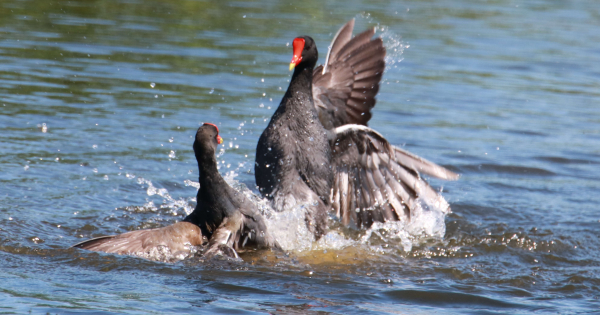
As bird photographers, we are always looking for action photo opportunities. After we get the basic portrait photos of a species or a given bird, we’re waiting for some action. It can be as simple as a bird stretching its wings, or preening, or taking flight. We never know what to expect with birds, but they can give us a clue or 2 that something is about to happen, or something has the potential to erupt. Realistically, real fights between birds don’t happen often. There may be some displaying, wing-spreading, an aggressive lunge, all of which might be accompanied by an aggressive call; but usually one bird gives way and that’s that.
When territory is involved, whether a feeding territory or especially a nesting territory, the usual give and take can elevate to something more – something more aggressive, more intense, more serious, more physical. Usually it involves 2 males at the edge of their perceived territories, and the main event, if there is one, is usually forecast by a series of species-specific displays. That may be all the farther it goes, except in extreme cases. After all, birds need to protect themselves and the best way to do that is to avoid physical altercations.

Back to the Action
But back to the action: I was photographing Fulvous Whistling Ducks last spring in an open area on the edge of a cattail marsh when a couple usually docile Common Gallinules made their way to a central point and began circling one another with their heads low to the water in aggressive posture, circling, then the volcano erupted with water flying and wings spread backward to prop the gallinules up while they kicked their legs and raked their long clawed toes at one another!
It was quite a scene, but my photo action didn’t start there. As soon as the birds lowered their heads and began circling one another, just inches away from one another, I knew there may be a little altercation, so I focused my attention, and my lens, on the gallinules. And that’s the key to any action photography; be aware and be ready – and hopefully, be in position. I was lucky to already be in position to photograph the rare ducks, with perfect attention to lighting during mid- to late afternoon, with the sun positioned behind me and the birds before me.

I also had my camera set in advance for the Fulvous photo session with my Mode dialed to ‘Av’ (aperture priority), with my aperture set at f8, which gave me a fast shutter speed of 1/800 at ISO 400. The aperture was wide enough to keep both gallinules in focus along with adjacent spraying water. And the shutter speed was fast enough to not only stop the action of the birds, but also the movement of the water that was spraying around them during most of the action.
In retrospect, if the shutter speed was slower, it would have showed more movement in the form of slightly blurred action of the birds, as well as the sprays of water around them, which would be another option for an action series like this; but I think the resulting stop-action images made the grade as best they could.

As the gallinule fight erupted I was quick to respond and took a series of photos at what I perceived to be optimum moments. In all, it was fast-paced unplanned fun that I didn’t plan on or prepare for, but I was prepared and excited to take appropriate action as I saw the potential of a waterbird fight evolving. The fight continued for an extended period, longer than most to be sure, and I kept pressing the shutter button not only to take photos but also to re-activate the autofocus as the birds repositioned during the interchange.
As one gallinule appeared to be getting the worst of it and looked for an out, I kept on focus to get a fleeting image of both gallinules rushing in opposite directions. That final image actually does show some blurring of the birds and the water. That was the end of the encounter, with neither bird interested in gloating or punctuating the fight in any way, leading me to think they might have been equally satisfied with some version of the status quo and uninterested in where the exact property line was located. Despite repeated contact with sharp toe nails, neither bird appeared to have lost a feather, and I hope they were fine and learned to temper their genetic and hormone induced rage.

It was exciting to have been able to photograph the entire interaction from start to finish. The resulting photos are testament to always be aware, be prepared, be in position, anticipate, and follow through to the end – just in case a fight breaks out!
Article and photographs by Paul Konrad
Share your bird photos and birding experiences at editorstbw2@gmail.com